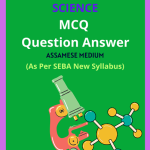Class 8 Science MCQ Chapter 8 Cell-Structures and Functions Solutions in English Medium, Class 8 Science Multiple Choice Question Answer in English to each chapter is provided in the list so that you can easily browse throughout different chapters Class 8 Science MCQ Chapter 8 Cell-Structures and Functions Notes and select need one.
Class 8 Science MCQ Chapter 8 Cell-Structures and Functions
Also, you can read the SCERT book online in these sections Class 8 Science Objective Type Solutions by Expert Teachers as per SCERT (CBSE) Book guidelines. These solutions are part of SCERT All Subject Solutions. Here we have given Assam Class 8 Science MCQs Solutions in English for All Subject, You can practice these here.
Cell-Structures and Functions
Chapter – 8
| MCQ |
1. The powerhouse of cell is called:
(a) Cell wall.
(b) Mitochondria.
(c) Ribosomes.
(d) Nucleus.
Ans: (b) Mitochondria.
2. The kitchen of the cell is called:
(a) Cell wall.
(b) Nucleus.
(c) Vacuoles.
(d) Plastids.
Ans: (d) Plastids.
3. The functional unit of life is called:
(a) Cell.
(b) Egg.
(c) Nucleus.
(d) None of these.
Ans: (a) Cell.
4. Chloroplast is found in-
(a) Plant cell only.
(b) Animal cell only.
(c) Both of these.
(d) None of these.
Ans: (a) Plant cell only.
5. The control unit of cell is:
(a) Nucleus.
(b) Cell wall.
(c) Cytoplasm.
(d) All of these
Ans: (a) Nucleus.
6. Single celled organisms are called:
(a) Unicellular.
(b) Multi-cellula.
(c) Both of these.
(d) None of these.
Ans: (a) Unicellular.
7. Tissue is a-
(a) Group of organs.
(b) Group of cells.
(c) Group of tissues.
(d) Group of organisms.
Ans: (b) Group of cells.
8. Cell is discovered by:
(a) Robert Brown.
(b) Robert Hook.
(c) John Mendal.
(d) Charles Darwin.
Ans: (b) Robert Hook.
9. The calls capable of changing shapes are:
(a) Amoeba cell.
(b) WBC.
(c) Both of these.
(d) None of these.
Ans: (c) Both of these.
10. Hen’s egg is a-
(a) Tissue.
(b) Organ.
(c) Organ system.
(d) cell.
Ans: (d) cell.
11. What is a cell?
(a) smallest and advanced unit of life.
(b) smallest and basic unit of life.
(c) largest and basic unit of life.
(d) largest and advanced unit of life.
Ans: (b) smallest and basic unit of life.
12. Which of the following is a functional unit of a body?
(a) Mitochondria.
(b) Cytoplasm.
(c) Spleen.
(d) Cell.
Ans: (d) Cell.
13. What is cell biology?
(a) Study of cell division only.
(b) Study of cancerous cell.
(c) Study of cell structure and function.
(d) Study of metaphase of a cell.
Ans: (c) Study of cell structure and function.
14. Which of the following is used by cells to interact with other cells?
(a) Cell tubules.
(b) Cell junctions.
(c) Cell adhesions.
(d) Cell detectors.
Ans: (b) Cell junctions.
15. In which of the following type of cells the cell junction is abundant?
(a) Cardiac cells.
(b) Prokaryotic cells.
(c) Hepatic cells.
(d) Epithelial cells.
Ans: (d) Epithelial cells.

Hi! my Name is Parimal Roy. I have completed my Bachelor’s degree in Philosophy (B.A.) from Silapathar General College. Currently, I am working as an HR Manager at Dev Library. It is a website that provides study materials for students from Class 3 to 12, including SCERT and NCERT notes. It also offers resources for BA, B.Com, B.Sc, and Computer Science, along with postgraduate notes. Besides study materials, the website has novels, eBooks, health and finance articles, biographies, quotes, and more.




